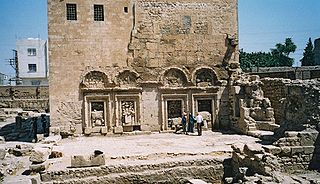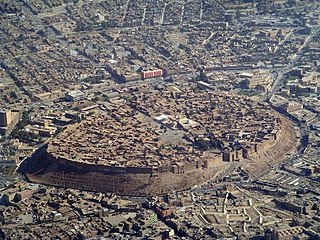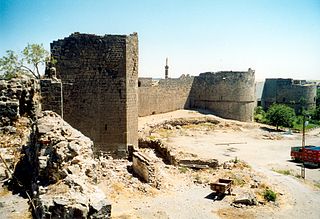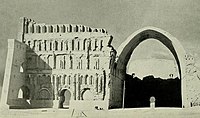Related Research Articles

At the height of its power, in the 10th century AD, the dioceses of the Church of the East numbered well over a hundred and stretched from Egypt to China. These dioceses were organised into six interior provinces in Mesopotamia, in the Church's Iraqi heartland, and a dozen or more second-rank exterior provinces. Most of the exterior provinces were located in Iran, Central Asia, India and China, testifying to the Church's remarkable eastern expansion in the Middle Ages. A number of East Syriac dioceses were also established in the towns of the eastern Mediterranean, in Palestine, Syria, Cilicia and Egypt.
The Metropolitanate of Maishan or Maysan was an East Syriac metropolitan province of the Church of the East between the fifth and thirteenth centuries. The historical region of Maishan or Maysan is situated in southern Iran. The metropolitans of Maishan sat at Prath d'Maishan, and for most of its history the province had three suffragan dioceses, at Karka d'Maishan, Rima and Nahargur. The last metropolitan of Maishan, the noted East Syriac author Shlemun (Solomon) of Basra, is attested in 1222, and it is not clear when the province ceased to exist.

Metropolitanate of Beth Garmai was an East Syriac metropolitan province of the Church of the East between the fifth and fourteenth centuries. The region of Beth Garmai is situated in northern Iraq, bounded by the Little Zab and Diyala Rivers and centered on the town of Karka d'Beth Slokh. Several bishops and metropolitans of Beth Garmaï are mentioned between the fourth and fourteenth centuries, residing first at Shahrgard, then at Karka d'Beth Slokh, later at Shahrzur and finally at Daquqa. The known suffragan dioceses of the metropolitan province of Beth Garmaï included Shahrgard, Lashom (ܠܫܘܡ), Khanijar, Mahoze d'Arewan, Radani, Hrbath Glal (ܚܪܒܬܓܠܠ), Tahal and Shahrzur. The suffragan dioceses of 'Darabad' and 'al-Qabba', mentioned respectively by Eliya of Damascus and Mari, are probably to be identified with one or more of these known dioceses. The diocese of Gawkaï, attested in the eighth and ninth centuries, may also have been a suffragan diocese of the province of Beth Garmaï. The last known metropolitan of Beth Garmaï is attested in the thirteenth century, and the last known bishop in 1318, though the historian ʿAmr continued to describe Beth Garmai as a metropolitan province as late as 1348. It is not clear when the province ceased to exist, but the campaigns of Timur Leng between 1390 and 1405 offer a reasonable context.

The Patriarchal Province of Seleucia-Ctesiphon was an ecclesiastical province of the Church of the East, with see in Seleucia-Ctesiphon. It was attested between the fifth and thirteenth centuries. As its name entails, it was the province of the patriarch of the Church of the East. The province consisted of a number of dioceses in the region of Beth Aramaye, between Basra and Kirkuk, which were placed under the patriarch's direct supervision at the synod of Yahballaha I in 420.

The Metropolitanate of Nisibis was an East Syriac metropolitan province of the Church of the East, between the fifth and seventeenth centuries. The ecclesiastical province of Nisibis had a number of suffragan dioceses at different periods in its history, including Arzun, Beth Rahimaï, Beth Qardu, Beth Zabdaï, Qube d’Arzun, Balad, Shigar (Sinjar), Armenia, Beth Tabyathe and the Kartawaye, Harran and Callinicus (Raqqa), Maiperqat, Reshʿaïna, Qarta and Adarma, Qaimar and Hesna d'Kifa. Aoustan d'Arzun and Beth Moksaye were also suffragan dioceses in the fifth century.
Beth Huzaye or ʿIlam was an East Syriac metropolitan province of the Church of the East, between the fifth and fourteenth centuries. The metropolitan bishops of Beth Huzaye sat at Beth Lapat (Jundishapur). The metropolitan province of Beth Huzaye had a number of suffragan dioceses at different periods in its history, including Karka d'Ledan, Hormizd Ardashir, Shushter, Susa, Ispahan, Mihraganqadaq and Ram Hormizd. The diocese of Shahpur Khwast may also have been a suffragan diocese of the province of Beth Huzaye.

Metropolitanate of Adiabene was an East Syriac metropolitan province of the Church of the East between the 5th and 14th centuries, with more than fifteen known suffragan dioceses at different periods in its history. Although the name Hadyab normally connoted the region around Erbil and Mosul in present-day Iraq, the boundaries of the East Syriac metropolitan province went well beyond the Erbil and Mosul districts. Its known suffragan dioceses included Beth Bgash and Adarbaigan, well to the east of Adiabene proper.
The Metropolitanate of Hulwan was an East Syriac metropolitan province of the Church of the East between the eighth and twelfth centuries, with suffragan dioceses for Dinawar, Hamadan, Nihawand and al-Kuj. The city of Hulwan was one of the chief towns in the western Iranian province of Media. The metropolitanate of Hulwan was ranked among the 'exterior provinces', so called to distinguish them from the province of the patriarch and the five core Mesopotamian 'interior' provinces.

Metropolitanate of Fars was an East Syriac metropolitan province of the Church of the East between the sixth and twelfth centuries. It was centered in what is now Fars Province, the historic cradle of ancient Persian civilization. Besides several centers in the Fars region itself, this East Syriac ecclesiastical province also included several dioceses in Arabia and a diocese for the island of Soqotra.
The Metropolitanate of Merv was an East Syriac metropolitan province of the Church of the East, between the fifth and eleventh centuries, with several known suffragan dioceses.
The Metropolitanate of Rai was an East Syriac metropolitan province of the Church of the East, between the eighth and twelfth centuries. The province of Rai had a suffragan diocese for Gurgan.
For much of the nineteenth and twentieth centuries the district of Salmas in northwest Iran was an archdiocese of the Chaldean Catholic Church, now a part of the Chaldean Catholic Archeparchy of Urmyā.

Chaldean Catholic Eparchy of Seert was a diocese of the Chaldean Catholic Church, centered in Seert. It existed during the eighteenth, nineteenth and early-twentieth centuries. The diocese was ruined during the First World War.

The Diocese of Amid (Diyarbakir) was a diocese or archdiocese of the Chaldean Church from the sixteenth to the twentieth century. From at least the 13th century the city of Amid had been part of the Diocese of Maiperqat of the Church of the East; following the schism of 1552 it became the seat of its own diocese in the Chaldean Church.
The Diocese of Tirhan was an East Syriac diocese of the Church of the East, within the central ecclesiastical Province of the Patriarch. The diocese is attested between the sixth and fourteenth centuries.

The Patriarch of the Church of the East is the patriarch, or leader and head bishop of the Church of the East. The position dates to the early centuries of Christianity within the Sassanid Empire, and the Church has been known by a variety of names, including the Church of the East, Nestorian Church, the Persian Church, the Sassanid Church, or East Syrian.
Enosh was Patriarch of the Church of the East between 877 and 884.
ʿAbdishoʿ I was Patriarch of the Church of the East from 963 to 986.
The Diocese of Shigar and Beth ʿArabaye was an East Syriac diocese of the Church of the East in the metropolitan province of Nisibis, centred on the town of Sinjar. The diocese is attested between the sixth and fourteenth centuries.
Diocese of Armenia was an East Syriac diocese of the Church of the East between the fifth and fourteenth centuries. The diocese served members of the Church of the East in Armenia, and its bishops sat at Halat. The diocese is last mentioned in 1281, and probably lapsed in the fourteenth century during the disorders that attended the fragmentation of the Mongol empire.
References
Citations
- ↑ Harrak, Amir. The acts of Mār Mārī the apostle , page 69 (BRILL 2005).
- 1 2 Houtsma, Martijn. E.J. Brill's first encyclopedia of Islam, 1913-1936 , pages 800-801 (BRILL 1993).
- ↑ Mari, 5 (Arabic) (ed. Gismondi)
- ↑ Chabot, 272
- ↑ Chronicle of Seert, i. 26
- ↑ Sliba, 111 (Arabic)
- ↑ Chronicle of Seert, i. 26
- 1 2 3 4 Fiey, POCN, 102
- ↑ Fiey, SS, 18–19
- ↑ Chabot, 274
- ↑ Chabot, 287
- ↑ Chabot, 306
- ↑ Chabot, 315
- ↑ Chabot, 366
- ↑ Chabot, 368
- ↑ Chabot, 423
- ↑ Wood, 203.
- ↑ Chabot, 478
- ↑ Sliba, 56–7 (Arabic)
- ↑ Elijah of Nisibis, Chronography, i. 80
- ↑ Chabot, 607
- ↑ Sliba, 73 (Arabic)
- ↑ Mari, 82–3 (Arabic), 73 (Latin)
- ↑ Mari, 90 (Arabic), 79 (Latin)
- ↑ Mari, 99 (Arabic), 88 (Latin)
- ↑ Mari, 103 (Arabic), 91 (Latin)
- ↑ Sliba, 95 (Arabic)
- ↑ Elijah of Nisibis, Chronography, i. 35
- ↑ Mari, 121 (Arabic), 107 (Latin)
- ↑ Mari, 130 (Arabic), 114 (Latin)
- ↑ Mari, 138 (Arabic), 118 (Latin)
- ↑ Mari, 155 (Arabic), 131 (Latin)
- ↑ Sliba, 111 (Arabic)
- ↑ Annuario Pontificio 2013 (Libreria Editrice Vaticana 2013 ISBN 978-88-209-9070-1), p. 911
- ↑ GCatholic with incumbent bio links
Bibliography
- Abbeloos, J. B., and Lamy, T. J., Bar Hebraeus, Chronicon Ecclesiasticum (3 vols, Paris, 1877)
- Assemani, J. S., Bibliotheca Orientalis Clementino-Vaticana (4 vols, Rome, 1719–28)
- Chabot, Jean-Baptiste (1902). Synodicon orientale ou recueil de synodes nestoriens (PDF). Paris: Imprimerie Nationale.
- Fiey, J. M., Assyrie chrétienne (3 vols, Beirut, 1962)
- Fiey, Jean Maurice (1979) [1963]. Communautés syriaques en Iran et Irak des origines à 1552. London: Variorum Reprints. ISBN 9780860780519.
- Fiey, Jean Maurice (1993). Pour un Oriens Christianus Novus: Répertoire des diocèses syriaques orientaux et occidentaux. Beirut: Orient-Institut. ISBN 9783515057189.
- Fiey, Jean Maurice (2004). Saints syriaques. Darwin Press.
- Gismondi, H., Maris, Amri, et Salibae: De Patriarchis Nestorianorum Commentaria I: Amri et Salibae Textus (Rome, 1896)
- Gismondi, H., Maris, Amri, et Salibae: De Patriarchis Nestorianorum Commentaria II: Maris textus arabicus et versio Latina (Rome, 1899)
- Harrak, A., The Acts of Mar Mari the Apostle (Atlanta, 2005)
- Wallis Budge, E. A., The Book of Governors: The Historia Monastica of Thomas, Bishop of Marga, AD 840 (London, 1893)
- Wilmshurst, David (2000). The Ecclesiastical Organisation of the Church of the East, 1318–1913. Louvain: Peeters Publishers. ISBN 9789042908765.
- Wilmshurst, David (2011). The martyred Church: A History of the Church of the East. London: East & West Publishing Limited. ISBN 9781907318047.
- Wood, Philip (2013). The Chronicle of Seert: Christian Historical Imagination in Late Antique Iraq. Oxford University Press.
